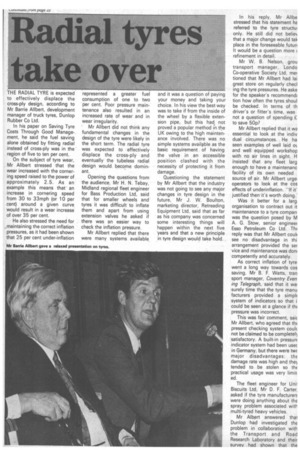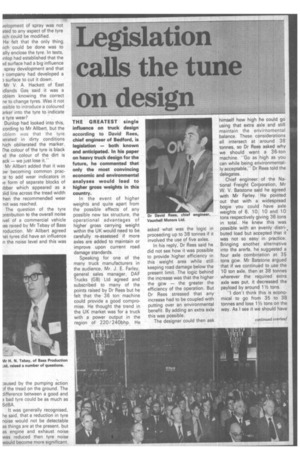THE RADIAL TYRE is expected to effectively displace the cross-ply
Page 26

Page 27

If you've noticed an error in this article please click here to report it so we can fix it.
design, according to Mr Barrie Allbert, development manager of truck tyres, Dunlop Rubber Co Ltd.
In his paper on Saving Tyre Costs Through Good Management, he said the fuel saving alone obtained by fitting radial instead of cross-ply was in the region of five to ten per cent.
On the subject of tyre wear, Mr Allbert stressed that the wear increased with the cornering speed raised to the power of approximately 2.5. As an example this means that an increase in cornering speed from 30 to 33mph (or 10 per cent) around a given curve would result in a wear increase of over 35 per cent.
He also stressed the need for ,maintaining the correct inflation pressures, as it had been shown that 25 per cent under-inflation represented a greater fuel consumption of one to two per cent. Poor pressure maintenance also resulted in an increased rate of wear and in wear irregularity.
Mr Allbert did not think any fundamental changes in the design of the tyre were likely in the short term. The radial tyre was expected to effectively displace the cross-ply and eventually the tubeless radial design would become dominant.
Opening the questions from the audience, Mr H. N. Tebay, Midland regional fleet engineer for Bass Production Ltd, said that for smaller wheels and tyres it was difficult to inflate them and apart from using extension valves he asked if there was an easier way to check the inflation pressure.
Mr Allbert replied that there were many systems available and it was a question of paying your money and taking your choice. In his view the best way was to take if from the inside of the wheel by a flexible extension pipe, but this had not proved a popular method in the UK owing to the high maintenance involved. There was no simple systems available as the basic requirement of having the valve in an accessible position clashed with the necessity of protecting it from damage.
Questioning the statement by Mr Allbert that the industry was not going to see any major changes in tyre design in the future, Mr J. W. Boulton, marketing director, Retreading Equipment Ltd, said that as far as his company was concerned some interesting things will happen within the next five 'years and that a new principle in tyre design would take hold.. In his reply, Mr Allbe stressed that his statement ha referred to the tyre structui only. He still did not belie% that a major change would tak place in the foreseeable futurr It would be a question more r refinement in detail.
Mr W. B. Nelson, grou transport manager, Londo Co-operative Society Ltd, met tioned that Mr Allbert had lai great store on regularly checl ing the tyre pressures. He aske for the speaker's recommend; tion how often the tyres shoul be checked. In terms of th driver's or fitter's time, was not a question of spending E to save 50p?
Mr Allbert replied that it we essential to look at the indiv dual circumstances. He ha seen examples of well laid ot. and well equipped workshop with no air lines in sight. H insisted that any fleet larg enough to have a maintenanc facility of its own needed source of air. Mr Allbert urge. operators to look at the cos effects of underinflation. "If it' justified then it's worth doing.'
Was it better for a larg organisation to contract out it maintenance to a tyre companwas the question posed by M A. G. Stow, senior engineer Esso Petroleum Co Ltd. Thr reply was that Mr Allbert coull see no disadvantage in thi arrangement provided the set vice and maintenance was doni competently and accurately.
As correct inflation of tyre: went a long way towards cos saving, Mr B. F. Watts, tran sport manager, Coventry Even ing Telegraph, said that it wai surely time that the tyre manu facturers provided a simpli system of indicators so that i could be seen at a glance if thr pressure was incorrect.
This was fair comment, saic Mr Allbert, who agreed that thr present checking system coulc not be claimed to be cornpletel satisfactory. A built-in pressurE indicator system had been usec in Germany, but there were twc major disadvantages: thE damage rate was high and the tended to be stolen so thE practical usage was very limit ed.
The fleet engineer for Unii Biscuits Ltd, Mr D. F. Carter, asked if the tyre manufacturers were doing anything about the spray problem associated with multi-tyred heavy vehicles.
Mr Albert answered that Dunlop had investigated the problem in collaboration with the Transport and Road Research Laboratory and their survey had shown that the Jelopment of spray was not Med to any aspect of the tyre lich could be modified.
He felt that the only thing. iich could be done was to ally enclose the tyre. In tests, Inlop had established that the id surface had a big influence spray development and that company had developed a 2 surface to cut it down.
Mr V. A. Hackett of East idlands Gas said it was a oblem knowing the correct le to change tyres. Was it not issible to introduce a coloured arker into the tyre to indicate e tyre wear?
Dunlop had looked into this, :cording to Mr Allbert, but the oblem was that the tyre )erated in dirty conditions hich obliterated the marker.. rhe colour of 'the tyre is black Id the colour of the dirt is ack — we just lose it.
Mr Allbert added that it was 2vv becoming common prac;e to add wear indicators in le form of separate blocks of ibber which appeared as a Aid line across the tread width 'hen the recommended wear -nit was reached.
The question of the tyre 2ntribution to the overall noise ivet of a commercial vehicle as raised by Mr Tebay of Bass roduction. Mr Allbert agreed iat tyres did have an influence n the noise level and this was
:laused by the pumping action 2.1 the tread on the ground. The lifference between a good and a bad tyre could be as much as 6d BA.
It was generally recognised, he said, that a reduction in tyre noise would not be detectable as things are at the present, but as engine and exhaust noise was reduced then tyre noise would become more significant.




















































































